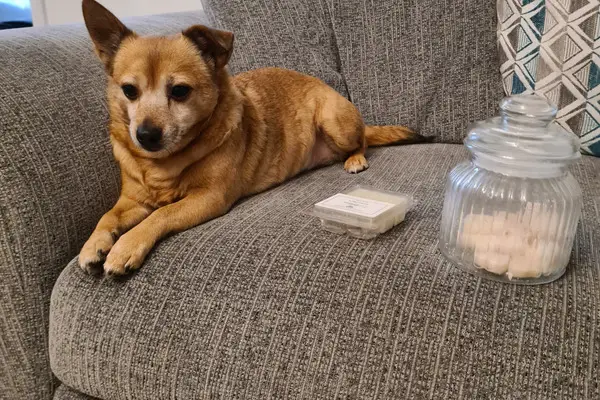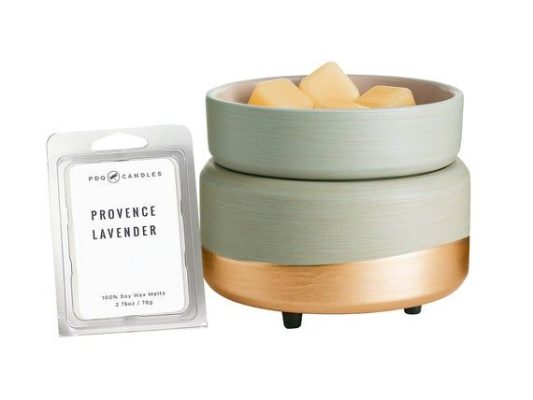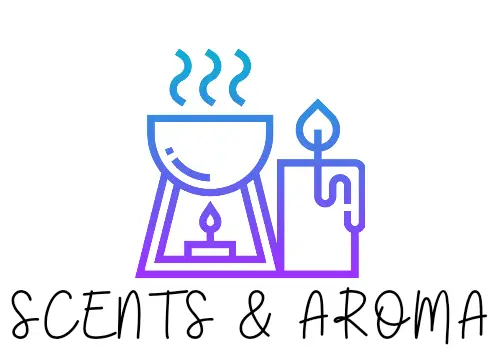Many people love adding scents to their home. However, humans’ sense of smell is one of the most primitive of all our senses. A smell or scent has the power to trigger memories from many years ago.
They can also alter a person’s behaviour or mood. So, while most people enjoy scents, we need to check how safe they are for our animals.

So, are wax melts safe for pet cats and dogs? If used with caution and care, there are some wax melts that are safe to use around your pet cats and dogs. However you first need to make sure that they do not contain dangerous essential oils that your animal could have a reaction to. Also try to use a natural wax such as Soy wax to avoid paraffin poisoning.
Let’s take a look in more detail at what your options are when you want to use wax melts around your family pets.
Before we go any further I just want to take a moment to show you my favorite pet friendly wax melts. They are natural and made of pure soy wax so that you can melt until your heart is content whilst keeping your beloved furry friends safe. Have a look by clicking on this link to Amazon (do not worry it opens in a new window).

Are wax melts safe for dogs and cats?
Typically, when we talk about things being safe for pets, we’re often referring to ones that have free reign of the home like dogs and cats. There might be the odd person with a house rabbit but generally, other animals are kept out of the way in cages or enclosures.
For cats, wax melts could pose more of a problem. This is because they are often much more sensitive to some of the ingredients in wax melts, like scents and essential oils. What’s more, cats can get higher up on furniture and cupboards so they can access wax burners or wax melts even when you think they’re out of reach.
It is best to make sure that your wax melts are not accessible to your person by following the information in my wax melt storage guide.
Choosing the right equipment and ingredients
In terms of the safety, electric warmers are safer to have around pets for obvious reasons. With a flameless warmer, your pet’s respiratory system will thank you. What’s more, your pet won’t accidentally knock over a flame or burn themselves. The only fire risk of an electric warmer is if something flammable touches the heated plate, and it’s very unlikely that a pet can do that!
Good wax warmers are touch-friendly. They work by heating up the wax just enough for it to melt and release the fragrance rather than burning a fuel. This means that the warmer or wax won’t burn your pet’s skin.
Being smoke-free is important. Burning candles can release toxins and soot into the air, which your pets can inhale. Certain types of wax are much worse than others for producing harmful substances. For example, some wicks of scented candles also use lead. Lead is harmful and long-term exposure poses health risks to your pet as well as to you.
That is why I recommend woodwicks when selecting scented candles.
Paraffin and soy wax melts
When you choose wax melts for your pet, looking at the ingredients is vital. You should avoid paraffin at all costs. This is a by-product of petroleum production and contains all sorts of toxins and carcinogens, including benzene. These toxins are harmful to your pet’s central nervous system and they can also trigger problems with the respiratory system.
Have a read of this article that I wrote about the toxicity of paraffin wax candles for more information.
Choosing a naturally-derived wax like soy wax or beeswax will be much better for your pet and for you. Be careful, though. To be labelled soy wax or beeswax, a candle only needs to be 51% soy or beeswax, which means the other ingredients might be paraffin. That’s why it’s essential to look at the wax melt’s list of ingredients.
Fragrance oil and essential oil wax melts
Artificial scents can cause problems for your pets and certain scents and essential oils are toxic to cats and dogs. Even if a scent is deemed safe, it doesn’t mean that your pet will enjoy the scent so trial and error is needed.
Dogs, for example, have in the region of 300 million olfactory receptors while humans have six million. What’s more, dogs’ brains are forty times better than ours at analysing a smell. As a result, a dog’s sense of smell cannot be replicated by any artificial instrument, which shows you just how sensitive your dog will be to odours.
Cats don’t have as strong a sense of smell as dogs, but it’s still pretty impressive. Cats have over 200 million olfactory receptors and their sense of smell is around fourteen times better than ours. So even though their sense of smell is not as good as a dog’s, it’s still pretty impressive.
Which essential oils and scents are toxic to pets?
Toxic essential oils include cinnamon, citrus (d-limonene), pennyroyal, pine, peppermint, sweet birch, tea tree (melaleuca), ylang-ylang, eucalyptus and wintergreen.
These are more of a problem when they are in their concentrated form and might not cause too many problems if used in a wax warmer.
That said, it’s not worth taking the risk, especially if a pet might consume the wax or get it on their skin. Signs of a problem include a dog or cat being unsteady on its feet.
Safe essential oils for cats include jasmine oil, lavender oil, rose oil, and chamomile oil. However, lavender as a plant does contain a small amount of linalool, which is a toxic compound for cats and dogs. That said, when lavender oil is used in a wax warmer, it isn’t a problem.
Safe essential oils for dogs include cedar oil, tangerine oil, lemongrass oil, lavender oil, and frankincense oil.
For more information about the difference between fragrance oils and essential oils and which is better check out my guide.
What do you need to do if your pet consumes wax?
Always bear in mind that wax melts are not designed to be ingested. So even if your wax melts are safe to use in a wax warmer, it does not mean they’re safe for your pets to consume.
Therefore, you should always keep them out of reach and clear the used wax from the warmer as soon as possible. Also, never leave your pet unattended in a room with a wax warmer that contains wax, whether warm or cool.
Despite your best intentions, accidents can happen. If you think your pet has ingested wax, you need to act fast.
Firstly, try and get any remaining wax out of your pet’s mouth to prevent them from swallowing it. Next, move any left-over wax out of the way so that your pet doesn’t consume any more.
Then, clean your pet’s mouth as best you can and monitor them. As this is a potential emergency, call your vet for advice. It’s a good idea to have a list of ingredients to hand and a rough idea of how much your pet has swallowed.
Final thoughts
So, while wax melts and wax warmers can be safe to use around pets, you do need to exercise caution.
First, choose natural waxes that contain non-toxic essential oils or fragrance oils.
Next, store all wax melts out of the way of pets and use an electric warmer to avoid soot and naked flames.
Finally, know what to do if your pet should consume some wax – clean their mouth, remove all wax from nearby, check the ingredients, and call your vet for advice.
- Can You Put Perfume In A Humidifier? (Read First) - September 17, 2022
- Can You Put Essential Oil In A Steam Mop? (Safety Advice) - September 17, 2022
- How To Make Lavender Oil At Home ( Candles And Diffusers) - September 9, 2022
